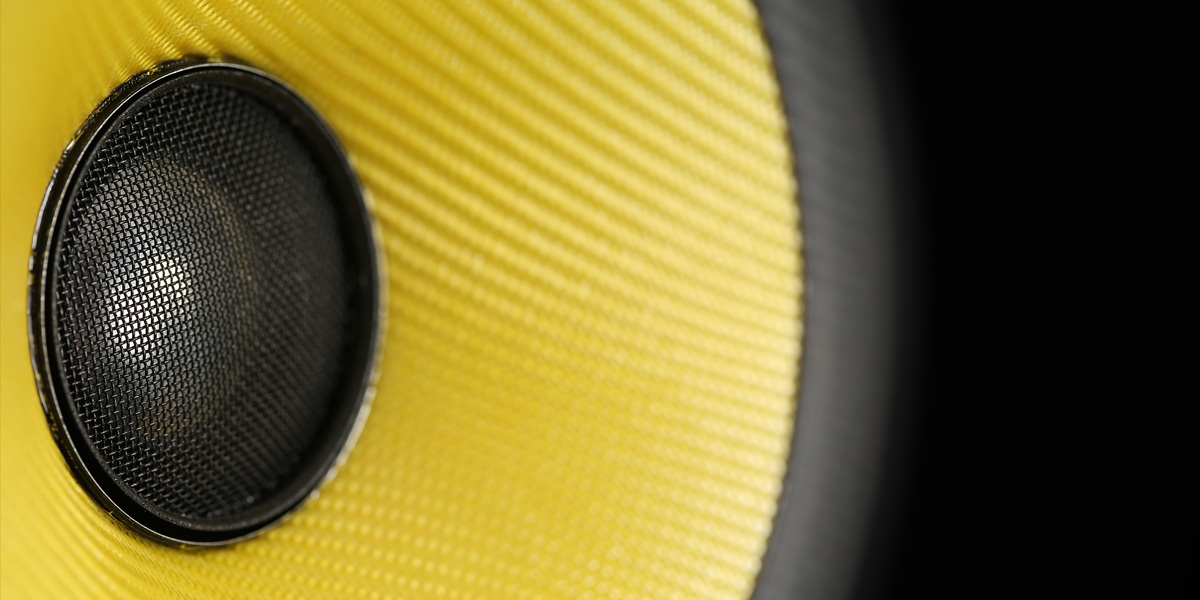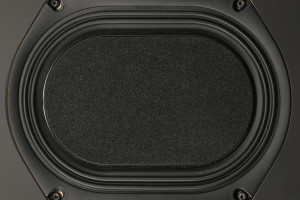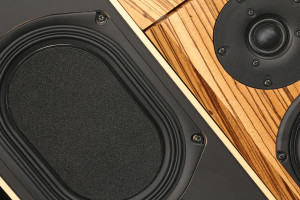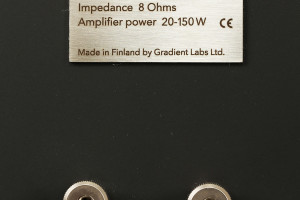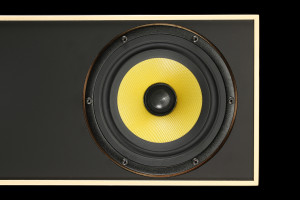In a world dominated by typical loudspeakers, Gradient company stands out. Open baffle designs are both a rarity today and retired CEO Jorma Salmi’s trademark. Yet recently something has changed as latest floorstanding addition to Finnish offer – Gradient 6.0 – looks surprisingly usual. Loaded with a very characteristic coaxial driver and a passive membrane it makes one wonder: what’s really going on in there?
Introduction
For the first time I witnessed Gradient sound in May 2013. In one of the most beautiful cities in Poland – Wrocław – during a two-day event known as “Audiofil”, Finnish Helsinki 1.5 floorstanders were presented. The outcome was that many visitors were a bit puzzled at first including yours truly, due to large 100 sq. meters room and rather modestly sized product. Though it could be seen that this $6’500 3-way dipole was much more than just an awkward and showy product, far from it. Its 30 cm bass driver is placed not towards the listener but mounted in a plywood made open baffle firing sideways. Remaining drivers sit in their polymer plates and a cardioidal radiation pattern soundwaves are the outcome. Many people would say that Helsinki 1.5 is a visual oddity but from an engineering standpoint it is quite the opposite. Once Finnish floorstanders started their performance, everyone payed full attention. A very wide sweetspot and quite stunning spaciousness were heard instantly. After this experience and some journalistic digging it all became clear. Jorma Salmi is the man behind the Gradient operation placed in a Finnish town of Porvoo. Said gent isn’t new to the speakers game, quite the contrary. One of his main principles from the get go was to make products as much room independent as possible and this hasn’t changed over the years. Quite spectacular soundstage, coherence and peculiar looks are direct upshots of Jorma’s speakers research performed for over more than a half a century. For some time he worked for Nokia as an RF waves engineer and then in Lohja Corporation’s consumer branches; television and loudspeakers. While working for the latter company, he managed an acoustical laboratory, has conducted many experiments and over many years of said operation he possessed an extensive knowledge about exact impact an environment has on sound. Then Jorma founded Gradient Ltd. in 1984 and – needless to say – he started making loudspeakers for home audio.
Once Finnish floorstanders started their performance, everyone payed full attention. A very wide sweetspot and quite stunning spaciousness were heard instantly. After this experience and some journalistic digging it all became clear. Jorma Salmi is the man behind the Gradient operation placed in a Finnish town of Porvoo. Said gent isn’t new to the speakers game, quite the contrary. One of his main principles from the get go was to make products as much room independent as possible and this hasn’t changed over the years. Quite spectacular soundstage, coherence and peculiar looks are direct upshots of Jorma’s speakers research performed for over more than a half a century. For some time he worked for Nokia as an RF waves engineer and then in Lohja Corporation’s consumer branches; television and loudspeakers. While working for the latter company, he managed an acoustical laboratory, has conducted many experiments and over many years of said operation he possessed an extensive knowledge about exact impact an environment has on sound. Then Jorma founded Gradient Ltd. in 1984 and – needless to say – he started making loudspeakers for home audio. Gradient 1.0 was the very first commercial product Jorma released. After a while he also wanted it to look more modern. Avanti monitor was the outcome of his cooperation with Finnish interior designer Jukka Vaajakallio. Said speaker gained Gradient quite a recognition and was awarded with several prestigious prizes in the process. Visually reworked Gradient 1.0 model simply known as Gradient 1.3 appeared next. It serves as an exhibit in museums of industrial art in Helsinki and Tokyo and was the first one Jorma exported. Another milestone in Gradient’s history was Revolution model introduced in 1994 and after all those years it’s still in production.
Gradient 1.0 was the very first commercial product Jorma released. After a while he also wanted it to look more modern. Avanti monitor was the outcome of his cooperation with Finnish interior designer Jukka Vaajakallio. Said speaker gained Gradient quite a recognition and was awarded with several prestigious prizes in the process. Visually reworked Gradient 1.0 model simply known as Gradient 1.3 appeared next. It serves as an exhibit in museums of industrial art in Helsinki and Tokyo and was the first one Jorma exported. Another milestone in Gradient’s history was Revolution model introduced in 1994 and after all those years it’s still in production. There are at least several key products in Gradient’s portfolio, namely aforementioned Helsinki 1.5 or Revolution’s smaller sibling known as Evidence. But Jorma gained worldwide attention thanks to a tiny two-way Prelude monitor loaded with a characteristic coaxial driver with yellow membrane. The man behind Combak Corporation’s (Reimyo, Harmonix, Enacom, Encore) – Kazuo Kiuchi – grew very fond of Prelude. Harmonix Bravo! model is the upshot of said gents cooperation and after more than a decade it’s also still in production. A while ago Jorma’s son – Atte – took over Gradient. He also has a technical background, for many years he worked for Finnish Vaisala corporation. It comes as no surprise that Atte inherited many things after his father and the passion for his usual speakers is one of them. Jorma and his son conjoined their efforts and Gradient 6.0 was born in the process. Though in comparison to earlier models it looks unusually normal. But rest assured that in 6.0’s case an apple also doesn’t fall too far away from a tree.
There are at least several key products in Gradient’s portfolio, namely aforementioned Helsinki 1.5 or Revolution’s smaller sibling known as Evidence. But Jorma gained worldwide attention thanks to a tiny two-way Prelude monitor loaded with a characteristic coaxial driver with yellow membrane. The man behind Combak Corporation’s (Reimyo, Harmonix, Enacom, Encore) – Kazuo Kiuchi – grew very fond of Prelude. Harmonix Bravo! model is the upshot of said gents cooperation and after more than a decade it’s also still in production. A while ago Jorma’s son – Atte – took over Gradient. He also has a technical background, for many years he worked for Finnish Vaisala corporation. It comes as no surprise that Atte inherited many things after his father and the passion for his usual speakers is one of them. Jorma and his son conjoined their efforts and Gradient 6.0 was born in the process. Though in comparison to earlier models it looks unusually normal. But rest assured that in 6.0’s case an apple also doesn’t fall too far away from a tree.
Design
With its 90 x 20,2 x 17,3 cm (H x W x D) dimensions and 12 kg mass, Gradient 6.0 is tiny to say the least whereas its visuals are undoubtedly Finnish, minimalistic. Subjectively, this non-flashy appearance is quite likeable. The enclosure is mostly wooden and finished in satin alike fashion. Birch plywood is used in both front and rear baffle and then covered in rubbery Fenix NTM material of Italian origin. Aesthetics aside it’s also extremely durable; scratch and high temperature proof. On said material’s homepage there is a rather convincing video with kitchen furniture heavily covered with it. Gradient 6.0 is available with white or black fronts and grills whereas third option is a completely white finish yet with MDF used instead of ply. Manufacturer says it has no impact on sound quality. The product is well-made, there’s no real reason to nitpick. Yes, a slight amount of unevenly distributed glue or lacquer is seen in its joints. But for yours truly this is a case of carpentry manufacturing and not sloppiness. That aside, I saw nothing disturbing. On Gradient’s 6.0 front there are only two elements; manufacturer’s aluminum logo and coaxial driver mounted way above it. Latter isn’t any random one but an effect of Jorma’s and Seas cooperation from many years ago. This particular unit is seen in Gradient 5.0, Harmonix Bravo! and Encore ENC-5 and said Finnish constructor dealt with each of these bookshelf models. Characteristic yellow membrane is made out of a fiberglass and has 176 mm diameter whereas 25 mm tweeter is an aluminum one. Seas has been making these drivers for more than 20 years. 6.0 model’s rear isn’t a typical one. Placed above aluminum plate with specs and a pair of a very decent speaker terminals, 140 x 200 mm passive radiator stands out. Even despite lack of typical ventilation, Finnish product is a bass-reflex design whereas said driver is used instead of a vent. According to Jorma, this solution fixes a common problem in most two-way speakers, namely the half-wave resonance in a bass-reflex port. According to Jorma, for instance if this element is 25 cm long, it will resonate at 686Hz. I wasn’t able to get to speakers guts but Atte was helpful in that regard. Polyester wadding is a damping material. Plastic film capacitors and air-cored inductors are used in a passive crossover. Low-pass filtration for bass/midrange is of 2nd order, 3rd order high-pass handles the tweeter. Crossover point for dual concentric driver is set quite high, at 2800 Hz. Speakers nominal impedance is 8 ohms whereas efficiency is an average 86 dB (2.83V/1m). Getting back to terminals, those are great; solid and able to accept any kind of cable termination there is.
On Gradient’s 6.0 front there are only two elements; manufacturer’s aluminum logo and coaxial driver mounted way above it. Latter isn’t any random one but an effect of Jorma’s and Seas cooperation from many years ago. This particular unit is seen in Gradient 5.0, Harmonix Bravo! and Encore ENC-5 and said Finnish constructor dealt with each of these bookshelf models. Characteristic yellow membrane is made out of a fiberglass and has 176 mm diameter whereas 25 mm tweeter is an aluminum one. Seas has been making these drivers for more than 20 years. 6.0 model’s rear isn’t a typical one. Placed above aluminum plate with specs and a pair of a very decent speaker terminals, 140 x 200 mm passive radiator stands out. Even despite lack of typical ventilation, Finnish product is a bass-reflex design whereas said driver is used instead of a vent. According to Jorma, this solution fixes a common problem in most two-way speakers, namely the half-wave resonance in a bass-reflex port. According to Jorma, for instance if this element is 25 cm long, it will resonate at 686Hz. I wasn’t able to get to speakers guts but Atte was helpful in that regard. Polyester wadding is a damping material. Plastic film capacitors and air-cored inductors are used in a passive crossover. Low-pass filtration for bass/midrange is of 2nd order, 3rd order high-pass handles the tweeter. Crossover point for dual concentric driver is set quite high, at 2800 Hz. Speakers nominal impedance is 8 ohms whereas efficiency is an average 86 dB (2.83V/1m). Getting back to terminals, those are great; solid and able to accept any kind of cable termination there is.
Sound
Gradient 6.0 is a very civilized product as its room requirements are minimal to say the least. It was designed to work in small or medium environments, namely from 15 to 35 square meters space. Generous air amount around many speakers is usually beneficial and KEF LS50 is one of many examples. When placed in the middle of the room this product will perform much better than with 30 centimeters of free space or so around it. Finnish speakers are of a completely different kind as in such airy circumstances their bass is nearly completely gone. But things drastically change once distance between their passive membranes and a wall is no smaller than 20 cm and no bigger than twice that. Gradient 6.0 being literally married to said surface is a mandatory condition, there is no other way around it. Unless one isn’t into full range performance that is. Modest space requirements combined with small form factor paint the picture of floorstanders feeling as comfy as a fish in the sea in nearly deadly environment for vast majority of competitors. It’s hard not to acknowledge how impressive space Gradient 6.0 create both in front and to the sides of the listener. To a degree this was to be expected. Equipped with a very similar (if not the same) driver, Harmonix Bravo! speakers perform in such way as well. But similarities don’t end here, an exceptionally good layering is something said products also share. Gradient 6.0 filled 25 sqm room with sound so effortlessly that notion of walls bottlenecking the presentation appeared almost instantly. Soundstaging aspect is undoubtedly one of Finnish speakers trading cards and coherence as a natural outcome of dual concentric driver usage is the other. Phantom images sketched precisely yet not overly stiff are presented in an extremely airy space. Layering is greatly varied and cohesive, first row is quite close yet without any effort next one is heard, and then next and next and so on. Brilliant. Gradient 6.0 sounds plainly big but musicians appear as humans not three meters tall giants. Everything is in order in this regard. Finnish boxes are able to show in an impressively convincing way vocalists both whispering closely and singing from afar.
It’s hard not to acknowledge how impressive space Gradient 6.0 create both in front and to the sides of the listener. To a degree this was to be expected. Equipped with a very similar (if not the same) driver, Harmonix Bravo! speakers perform in such way as well. But similarities don’t end here, an exceptionally good layering is something said products also share. Gradient 6.0 filled 25 sqm room with sound so effortlessly that notion of walls bottlenecking the presentation appeared almost instantly. Soundstaging aspect is undoubtedly one of Finnish speakers trading cards and coherence as a natural outcome of dual concentric driver usage is the other. Phantom images sketched precisely yet not overly stiff are presented in an extremely airy space. Layering is greatly varied and cohesive, first row is quite close yet without any effort next one is heard, and then next and next and so on. Brilliant. Gradient 6.0 sounds plainly big but musicians appear as humans not three meters tall giants. Everything is in order in this regard. Finnish boxes are able to show in an impressively convincing way vocalists both whispering closely and singing from afar. Yes, Gradient 6.0 is obviously a very spaciously sounding product and the listener doesn’t have to fully commit his/hers attention to hear it. Before Boenicke W8 and Blumenhoffers Genuin FS3 MKII arrival, yours truly hadn’t had speakers sounding this spacious. Even KEF LS50 generous in that regard falls short, both in terms of soundstage width and depth. It’s quite possible that Boenicke W5 could challenge Finnish product in said aspect yet with nowhere near its bass quantity when in a sub-less mode. Yes, Gradient 6.0 does low end exceptionally well but in a particular way, completely different in comparison to aforementioned LS50. Latter’s bass tends to be bloated in its upper range and forceful whereas the lowest parts are somewhat lacking. Yes, it is showy yet refinement isn’t there. Former product has rather generously developed lowest bass while everything above is dosed in mild, certainly not exaggerated amounts. Powerful, nearly rock crushing sensation is present in the process. Moments where it’s more felt than heard happen instead of any boominess. Subjectively this is such a nice change of pace after switching from LS50. Due to carefully dosed midbass, Gradient 6.0 might seem it has to have less low end than LS50. But of much greater quality and once i.e. double-bass line appears, it’s rather obvious that said floorstanders get the job done right.
Yes, Gradient 6.0 is obviously a very spaciously sounding product and the listener doesn’t have to fully commit his/hers attention to hear it. Before Boenicke W8 and Blumenhoffers Genuin FS3 MKII arrival, yours truly hadn’t had speakers sounding this spacious. Even KEF LS50 generous in that regard falls short, both in terms of soundstage width and depth. It’s quite possible that Boenicke W5 could challenge Finnish product in said aspect yet with nowhere near its bass quantity when in a sub-less mode. Yes, Gradient 6.0 does low end exceptionally well but in a particular way, completely different in comparison to aforementioned LS50. Latter’s bass tends to be bloated in its upper range and forceful whereas the lowest parts are somewhat lacking. Yes, it is showy yet refinement isn’t there. Former product has rather generously developed lowest bass while everything above is dosed in mild, certainly not exaggerated amounts. Powerful, nearly rock crushing sensation is present in the process. Moments where it’s more felt than heard happen instead of any boominess. Subjectively this is such a nice change of pace after switching from LS50. Due to carefully dosed midbass, Gradient 6.0 might seem it has to have less low end than LS50. But of much greater quality and once i.e. double-bass line appears, it’s rather obvious that said floorstanders get the job done right. Airy, spacious and coherent Gradient 6.0 is an effortless product to listen to. Yet it can hear that its tonal balance is shifted a bit upwards and saturation is less present than i. e. in Xavian Perla or AudioSolutions 0202B. Yet Finnish product doesn’t sound dry at all, density and coloring can be there with rather warm setup but simply aren’t among its top priorities, on contrary to superb clarity and lit-up character overall. Highs are surprisingly smooth even though tweeter might suggest it’s the other way around. Their decay, diversity and weigh are all there in generous amount but sparks aren’t. Perhaps with contour and dry companions this could be the case. But quality and detailed upper frequencies came without a price with electronics used in this publication. Midrange is simply there, neither recessed nor pushed forward. There might be a slight insufficiency to some people in i.e. electric guitars not being gutsy enough, yet texturing on said instruments and many other is proper and sterility isn’t a part of the mix.
Airy, spacious and coherent Gradient 6.0 is an effortless product to listen to. Yet it can hear that its tonal balance is shifted a bit upwards and saturation is less present than i. e. in Xavian Perla or AudioSolutions 0202B. Yet Finnish product doesn’t sound dry at all, density and coloring can be there with rather warm setup but simply aren’t among its top priorities, on contrary to superb clarity and lit-up character overall. Highs are surprisingly smooth even though tweeter might suggest it’s the other way around. Their decay, diversity and weigh are all there in generous amount but sparks aren’t. Perhaps with contour and dry companions this could be the case. But quality and detailed upper frequencies came without a price with electronics used in this publication. Midrange is simply there, neither recessed nor pushed forward. There might be a slight insufficiency to some people in i.e. electric guitars not being gutsy enough, yet texturing on said instruments and many other is proper and sterility isn’t a part of the mix. Finnish floorstanders first performance was with LampizatOr Level7 and Hegel H160. DSD playback on this setup was neither overly thick nor thin. Queen’s “I Want to Break Free” sounded incredibly spacious and surprisingly smooth whereas Norvegian integrated’s additional verve injection made things fast and tight. But marvelous layering and airness were also there. Kodo’s “Daraijin” served as a timing checker and Gradient 6.0 got it right. Each drum strike had an outstanding momentum and proper scale was also shown. To witness full coloring capabilities of Finnish product, I’ve used Boston’s “More Than a Feeling” in DSD version. Its usual features were shining but a bit more saturation was in order and Mike Oldfield’s DSD version of “Ommadawn” confirmed that. Trilogy 992 monos and 908 preamplifier were used instead of H160 to achieve the goal hopefully and said change turned out to be a bull’s-eye. Nic Poulson’s products somehow combine density with speed and resolution, Gradient 6.0 benefits from this greatly. It gained more density and smoothness yet key aspects were untouched. Differences between H160 and Trilogy products weren’t of day and night kind in many regards but perfectly audible. Nic’s hybrid setup showed clearly that Gradient 6.0 has a lot of potential just awaiting to be unleashed. After said experiments it was easily heard that these speakers have a very strong character. Boredom and dullness were never a part of the show. Finnish boxes do not deliver mellow, warm and midrange oriented sound like i.e. Roberto Barletta’s Perla. Speed, full range, airness, smoothness and an impressive soundstaging are the most prominent Gradient 6.0 aspects.
Finnish floorstanders first performance was with LampizatOr Level7 and Hegel H160. DSD playback on this setup was neither overly thick nor thin. Queen’s “I Want to Break Free” sounded incredibly spacious and surprisingly smooth whereas Norvegian integrated’s additional verve injection made things fast and tight. But marvelous layering and airness were also there. Kodo’s “Daraijin” served as a timing checker and Gradient 6.0 got it right. Each drum strike had an outstanding momentum and proper scale was also shown. To witness full coloring capabilities of Finnish product, I’ve used Boston’s “More Than a Feeling” in DSD version. Its usual features were shining but a bit more saturation was in order and Mike Oldfield’s DSD version of “Ommadawn” confirmed that. Trilogy 992 monos and 908 preamplifier were used instead of H160 to achieve the goal hopefully and said change turned out to be a bull’s-eye. Nic Poulson’s products somehow combine density with speed and resolution, Gradient 6.0 benefits from this greatly. It gained more density and smoothness yet key aspects were untouched. Differences between H160 and Trilogy products weren’t of day and night kind in many regards but perfectly audible. Nic’s hybrid setup showed clearly that Gradient 6.0 has a lot of potential just awaiting to be unleashed. After said experiments it was easily heard that these speakers have a very strong character. Boredom and dullness were never a part of the show. Finnish boxes do not deliver mellow, warm and midrange oriented sound like i.e. Roberto Barletta’s Perla. Speed, full range, airness, smoothness and an impressive soundstaging are the most prominent Gradient 6.0 aspects.
Summary
Gradient 6.0 doesn’t paint a sweet picture, it leans more towards truth and detailing and also serves as a proof that quite small, inconspicuous floorstanders can put many listeners in a state of positive shock soundwise as these sound plainly big. Jorma Salmi knew exactly what he was doing. Music this coherent, detailed and smooth isn’t a case of mere coincidence. 6.0’s soundstaging capabilities are enormous, the same story goes with precision. Once matched with dense companions, saturation also will be a part of the performance. Layering, airness and ability to show instrument’s sizes properly are aspects not one but many much bigger floorstanding speakers will envy Gradient’s latest addition. Marvelously punchy, springy, well-controlled and diversified low end serves as a tasty cherry on top. Just make sure to follow manufacturer’s spacing instructions as these are crucial.
Gradient 6.0 will perform spectacularly good in environments unfriendly enough to make most of competitors performance mediocre at best. Said speakers are an ideal choice not only when small rooms are involved but hostile destination place for these as well. Needless to say, Finnish model is finely made and – subjectively – visually appealing. Kudos to Atte Salmi as this is his doing. Minimalistic design he created blends in seamlessly in almost any surroundings yours truly can think of. Gradient 6.0 is not only a real looker and a world class performer. All things considered, its price/performance ratio is off the charts as in many regards it clearly is able to throw punches way above its weight. Getting back to LS50 was challenging and these surely won’t be missed. On contrary to positively surprising Finnish 6.0 floorstanders Salmi duo created. My sincere congratulations to said gents and ’till next time.
Associated equipment:
- Loudspeakers: KEF LS50
- Amplifiers: Hegel H60, Trilogy 992 + 908
- Source/preamplification: Psvane WE101D-L loaded LampizatOr Level7, jRiver fed HP Spectre laptop
- Power: GigaWatt PF-2 with LC-2 MK2 power cord
- Cables: Forza AudioWorks Noir series Twin USB cable and RCA interconnects supplemented by Noir concept power cords and speaker wires
- Audio furniture: Lavardin K-Rak
Reviewed product’s price in EU: €1’990/pr


